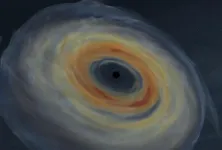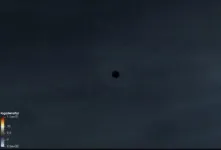(Press-News.org) The death of a massive, rapidly spinning star can shake the universe. And the resulting ripples — known as gravitational waves — could be felt by instruments on Earth, according to new research published August 22 in The Astrophysical Journal Letters. These new sources of gravitational waves just await discovery, the scientists behind the research predict.
The gravitational waves emerge following the violent deaths of rapidly rotating stars 15 to 20 times the mass of the sun. Upon running out of fuel, these stars implode, then explode, in an event known as a collapsar. This leaves behind a black hole surrounded by a large disk of leftover material that quickly whirls into the black hole’s maw. The spiraling of material — which lasts just minutes — is so great that it distorts the space around it, creating gravitational waves that travel across the universe.
Using cutting-edge simulations, the scientists determined that these gravitational waves could be detectable with instruments like the Laser Interferometer Gravitational-Wave Observatory (LIGO), which made the first direct observations of gravitational waves from merging black holes in 2015. If spotted, the collapsar-driven waves would help scientists understand the mysterious inner workings of collapsars and black holes.
“Currently, the only gravitational wave sources that we have detected come from a merger of two compact objects — neutron stars or black holes,” says study lead Ore Gottlieb, a research fellow at the Flatiron Institute’s Center for Computational Astrophysics (CCA) in New York City. “One of the most interesting questions in the field is: What are the potential non-merger sources that could produce gravitational waves that we can detect with current facilities? One promising answer is now collapsars.”
Gottlieb, along with CCA visiting scholar and Columbia professor Yuri Levin and Tel Aviv University professor Amir Levinson, simulated the conditions — including magnetic fields and cooling rates — found in the aftermath of a massive rotating star’s collapse. The simulations showed that collapsars can produce gravitational waves powerful enough to be visible from about 50 million light-years away. That distance is less than one-tenth the detectable range of the more powerful gravitational waves from mergers of black holes or neutron stars, though it’s still stronger than any non-merger event yet simulated.
The new findings come as a surprise, Gottlieb says. Scientists thought the chaotic collapse would create a jumble of waves that would be hard to pick out amid the universe’s background noise. Think of an orchestra warming up. When each musician plays their own notes, it can be hard to distinguish the melody coming from a single flute or tuba. On the other hand, gravitational waves from the merger of two objects create clear, strong signals like an orchestra playing together. This is because when two compact objects are about to merge, they dance in a tight orbit that creates gravitational waves with each turn. This rhythm of near-identical waves amplifies the signal to a level that can be detected. The new simulations showed that the rotating disks around collapsars can also emit gravitational waves that amplify together, very much like the orbiting compact objects in mergers.
“I thought that the signal would be much messier because the disk is a continuous distribution of gas with material spinning in different orbits,” Gottlieb says. “We found that the gravitational waves from these disks are emitted coherently, and they’re also rather strong.”
Not only is the predicted signal from collapsar disks strong enough to be detected by LIGO, but Gottlieb’s calculations suggest that a few events might already be in existing datasets. Proposed gravitational wave detectors such as the Cosmic Explorer and Einstein Telescope could spot dozens a year.
The gravitational wave community is already interested in looking for these events, but it is not an easy task. The new work calculated gravitational wave signatures for a modest number of potential collapsar events. Stars, however, span a wide range of mass and rotation profiles, which would create differences in the calculated gravitational wave signals.
“In principle, we would ideally simulate 1 million collapsars to be able to create a generic template, but unfortunately, these are very expensive simulations,” Gottlieb says. “So, for now, we have to pick other strategies.”
Scientists can look into historical data to see if any events are similar to the one Gottlieb simulated. Given the variety of stars, though, each with a potentially unique signal, finding a match for one of the simulated signals is probably unlikely. Another strategy is to use other signals from close by collapsar events — such as supernovae or gamma-ray bursts that are emitted during the star’s collapse — and then search the data archives to see if any gravitational waves were detected in that area of the sky around the same time.
Detecting collapsar-generated gravitational waves would help scientists better understand the inner structure of the star upon collapse and would also enable them to learn about the properties of black holes — two topics that remain poorly understood.
“These are things that we can otherwise not detect,” Gottlieb says. “The only way for us to study these inner stellar regions around the black hole is through gravitational waves.”
ABOUT THE FLATIRON INSTITUTE
The Flatiron Institute is the research division of the Simons Foundation. The institute's mission is to advance scientific research through computational methods, including data analysis, theory, modeling and simulation. The institute's Center for Computational Astrophysics creates new computational frameworks that allow scientists to analyze big astronomical datasets and to understand complex, multi-scale physics in a cosmological context.
END
New detectable gravitational wave source from collapsing stars predicted from simulations
The ripples in space-time caused by the death of massive spinning stars could be within the limits of detection of projects like LIGO and Virgo, new simulations by Flatiron Institute astrophysicists suggest
2024-08-22
ELSE PRESS RELEASES FROM THIS DATE:
New study examines use of opioids for chronic cough
2024-08-22
INDIANAPOLIS – Chronic cough, with symptoms lasting more than eight weeks, affects approximately one in 10 adults. Cough is among the most common reasons for seeking medical care in the United States, yet chronic cough is difficult to treat. One of the largest studies of chronic cough and one of the first to explore the use of opioids, which are known to suppress cough, to treat these patients, has found that 20 percent of patients with chronic cough received a prescription for a cough suppressant containing an opioid.
With the goals of estimating opioid prescription in the chronic cough population and of informing alternative treatment ...
SwRI develops novel methodology for measuring blood-brain barrier permeability
2024-08-22
SAN ANTONIO — August 22, 2024 —Scientists at Southwest Research Institute have developed a new screening method to identify drug formulations that can penetrate the blood-brain barrier (BBB), to facilitate treatment of brain diseases and conditions.
“The BBB protects the brain and central nervous system from potentially harmful substances in the bloodstream, regulating the transport of essential nutrients and ions while maintaining the stability of the central nervous system,” said Research Engineer Nicholas McMahon, from SwRI’s Bioengineering group. “However, the very characteristics that make the BBB such an ...
Role of bitter polyphenols in the regulation of blood sugar
2024-08-22
Bioactive compounds like polyphenols and their health benefits have long captured public attention and interest. Commonly present in plant-based food like fruits, vegetables, seeds, coffee, and tea, the polyphenols have a strong bitter taste and, in the normal course, is excreted by our body due to poor absorption.
The polyphenols interact with human bitter taste receptors also known as Type 2 taste receptors (T2R) expressed within and outside the oral cavity. Notably, the activation of T2R expressed along the ...
Promising treatment for rectal cancer confirmed in major study
2024-08-22
A new treatment for locally advanced rectal cancer shows favourable results in that surgery can sometimes be avoided completely. It also reduces the risk of recurrence. The method has been confirmed as effective in a comprehensive study conducted at Uppsala University and published in eClinicalMedicine.
“The tumour disappears completely more often, thereby increasing the chance of avoiding surgery and retaining normal rectum and rectal function. Moreover, there are fewer metastases,” says Bengt Glimelius, Professor of Oncology ...
Chronic cough may be hereditary
2024-08-22
Chronic cough is among the most common reasons for seeking medical care, with middle-aged women the group most affected. New studies at Uppsala University also show that this condition appears to be a hereditary phenomenon. The studies have been published in ERJ Open Research and PLOS ONE.
“More than 10% of the population has a chronic cough, which has been shown to entail several negative consequences: reduced quality of life, reduced ability to work and voice problems. At present, we have insufficient knowledge about ...
Universal flu vaccine candidate protects against infection in mice
2024-08-22
Highlights:
Flu vaccine efficacy varies year to year.
A universal flu vaccine would protect people against all influenza strains that infect humans and last more than a season.
A new vaccine candidate incorporates proteins from 8 strains of influenza.
Recent tests of the candidate show efficacy in animal models, and the researchers hope to move to clinical trials soon.
Washington, D.C.—Annual flu vaccines protect against severe infection, but they vary in efficacy and may not match the most virulent strains ...
$20M community-driven research funding aims to reduce inequities, improve health outcomes
2024-08-22
DALLAS, August 22, 2024 — A new $20 million research initiative will engage the people most impacted by health disparities in developing solutions that may help improve their overall health and well-being. The American Heart Association, celebrating 100 years of lifesaving service as the world’s leading nonprofit organization focused on heart and brain health for all, and the Robert Wood Johnson Foundation (RWJF), a leading national philanthropy dedicated to taking bold leaps to transform health, are ...
Novel redox-active metal-organic framework as an anode material for Li batteries operating in freezing conditions
2024-08-22
The Korea Institute of Energy Research (KIER) has developed a redox-active metal-organic hybrid electrode material (SKIER-5) for Li batteries that remains stable in cold conditions as low as minus 20 degrees Celsius. By addressing the limitations of graphite as an anode material of conventional Li batteries under freezing conditions, SKIER-5 has the potential to be a superior alternative. This novel material can be used in Li batteries for a variety of applications, including electric vehicles, drones, and ultra-small electronic devices, even in low temperatures.
Currently, ...
Mental health and chronic diabetes complications strongly linked both ways, study finds
2024-08-22
Heart attack, stroke, nerve damage.
These are just some of the complications for which millions of Americans with diabetes are at greater risk.
When a person has any of these chronic diabetes complications, they are more likely to have a mental health disorder, and vice versa, according to a University of Michigan-led study.
That is, the relationship goes both ways: having a mental health condition also increases the risk of developing chronic complications of diabetes.
“We wanted to see if chronic diabetes complications ...
Endoscopic treatment approaches for inflammatory bowel diseases: old friends and new weapons
2024-08-22
Inflammatory bowel diseases (IBD), comprising Crohn’s disease (CD) and ulcerative colitis (UC), are chronic inflammatory conditions affecting the gastrointestinal tract. These diseases can lead to various complications, including strictures, fistulas, and abscesses, significantly impacting patients' quality of life. Endoscopy plays a crucial role in diagnosing IBD, assessing disease activity, and monitoring treatment response. In recent years, advances in operative endoscopy have introduced ...
LAST 30 PRESS RELEASES:
Making lighter work of calculating fluid and heat flow
Normalizing blood sugar can halve heart attack risk
Lowering blood sugar cuts heart attack risk in people with prediabetes
Study links genetic variants to risk of blinding eye disease in premature infants
Non-opioid ‘pain sponge’ therapy halts cartilage degeneration and relieves chronic pain
AI can pick up cultural values by mimicking how kids learn
China’s ecological redlines offer fast track to 30 x 30 global conservation goal
Invisible indoor threats: emerging household contaminants and their growing risks to human health
Adding antibody treatment to chemo boosts outcomes for children with rare cancer
Germline pathogenic variants among women without a history of breast cancer
Tanning beds triple melanoma risk, potentially causing broad DNA damage
Unique bond identified as key to viral infection speed
Indoor tanning makes youthful skin much older on a genetic level
Mouse model sheds new light on the causes and potential solutions to human GI problems linked to muscular dystrophy
The Journal of Nuclear Medicine ahead-of-print tip sheet: December 12, 2025
Smarter tools for peering into the microscopic world
Applications open for funding to conduct research in the Kinsey Institute archives
Global measure underestimates the severity of food insecurity
Child survivors of critical illness are missing out on timely follow up care
Risk-based vs annual breast cancer screening / the WISDOM randomized clinical trial
University of Toronto launches Electric Vehicle Innovation Ontario to accelerate advanced EV technologies and build Canada’s innovation advantage
Early relapse predicts poor outcomes in aggressive blood cancer
American College of Lifestyle Medicine applauds two CMS models aligned with lifestyle medicine practice and reimbursement
Clinical trial finds cannabis use not a barrier to quitting nicotine vaping
Supplemental nutrition assistance program policies and food insecurity
Switching immune cells to “night mode” could limit damage after a heart attack, study suggests
URI-based Global RIghts Project report spotlights continued troubling trends in worldwide inhumane treatment
Neutrophils are less aggressive at night, explaining why nighttime heart attacks cause less damage than daytime events
Menopausal hormone therapy may not pose breast cancer risk for women with BRCA mutations
Mobile health tool may improve quality of life for adolescent and young adult breast cancer survivors
[Press-News.org] New detectable gravitational wave source from collapsing stars predicted from simulationsThe ripples in space-time caused by the death of massive spinning stars could be within the limits of detection of projects like LIGO and Virgo, new simulations by Flatiron Institute astrophysicists suggest







